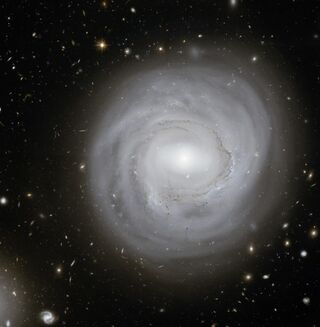Astronomy:NGC 4921
| NGC 4921 | |
|---|---|
 NGC 4921 in a combination of near-infrared and yellow light | |
| Observation data (J2000 epoch) | |
| Constellation | Coma Berenices |
| Right ascension | 13h 01m 26.1s[1] 209453.02 |
| Declination | +27° 53′ 09″[1] |
| Redshift | 0.018286; 5,482 km/s[2] |
| Distance | ca. 320 Mly[3] |
| Apparent magnitude (V) | 13.04[1] |
| Characteristics | |
| Type | SB(rs)ab[1] |
| Size | ~209,400 ly (64.21 kpc) (estimated)[1] |
| Apparent size (V) | 2.5′ × 2.2′[1] |
| Other designations | |
| UGC 08134, PGC 044899.[1] | |
NGC 4921 is a barred spiral galaxy in the Coma Cluster, located in the constellation Coma Berenices. It is about 320 million light-years from Earth.[3] The galaxy has a nucleus with a bar structure that is surrounded by a distinct ring of dust that contains recently formed, hot blue stars. The outer part consists of unusually smooth, poorly distinguished spiral arms.[4]
In 1976, the Canadian astronomer Sidney Van den Bergh categorized this galaxy as "anemic" because of the low rate at which stars are being formed. He noted that it has "an unusually low surface brightness and exhibits remarkably diffuse spiral arms". Nonetheless, it is the brightest spiral galaxy in the Coma Cluster.[5] This galaxy is located near the center of the cluster and has a high relative velocity (7,560 km/s)[6] compared to the mean cluster velocity. When examined at the 21 cm wavelength Hydrogen line, NGC 4921 was found to be strongly H I deficient, indicating that it is low in hydrogen. The distribution of hydrogen has also been deeply perturbed toward the SE spiral arm and is less extended than the optical disk of the galaxy. This may have been caused by interaction with the intergalactic medium, which is stripping off the gas via ram pressure.[7] Some filaments of gas that have been stripped away are falling back to the galaxy, making NGC 4921 possibly the first observational evidence of this fallback.[8]
On May 4, 1959, a supernova explosion was observed in this galaxy by M. L. Humason using a Schmidt telescope at the Palomar Observatory. It appeared "quite far from the center" of the galaxy,[9] and was designated as SN 1959B. It reached an estimated peak magnitude of 18.5.[10] The light curve proved similar to supernova SN 1987a in the Large Magellanic Cloud,[11] and it displayed "unusual photometric behavior".[9]
References
- ↑ 1.0 1.1 1.2 1.3 1.4 1.5 1.6 "NASA/IPAC Extragalactic Database". Results for NGC 4921. http://nedwww.ipac.caltech.edu/.
- ↑ Haynes, Martha P. (April 1997). "21 CM H1 Line Spectra of Galaxies in Nearby Clusters". Astronomical Journal 113: 1197–1211. doi:10.1086/118337. Bibcode: 1997AJ....113.1197H.
- ↑ 3.0 3.1 Atkinson, Nancy (2009-02-05). "Deep Hubble View of Unusual "Fluffy" Galaxy – and Beyond". Universe Today. http://www.universetoday.com/2009/02/05/deep-hubble-view-of-unusual-fluffy-galaxy-–-and-beyond/.
- ↑ Christensen, Lars Lindberg (2009-02-05). "Exceptionally deep view of strange galaxy". European Space Agency. http://www.esa.int/esaSC/SEMA1NXPXPF_index_0.html.
- ↑ van den Bergh, S. (1976-06-15). "A new classification system for galaxies". Astrophysical Journal 206: 883–887. doi:10.1086/154452. Bibcode: 1976ApJ...206..883V.
- ↑ The Astrophysical Journal 601 (1): 197–213. 2004-01-20. doi:10.1086/380195. Bibcode: 2004ApJ...601..197P.
- ↑ Bravo-Alfaro, H.; Cayatte, V.; van Gorkom, J. H.; Balkowski, C. (February 2000). "VLA HI Imaging of the brightest spiral galaxies in Coma.". The Astronomical Journal 119 (2): 580–592. doi:10.1086/301194. Bibcode: 2000AJ....119..580B.
- ↑ Cramer, W. J.; Kenney, J. D. P.; Tonnesen, S.; Smith, R.; Wong, T.; Jáchym, P.; Cortés, J. R.; Cortés, P. C. et al. (2021). "Molecular Gas Filaments and Fallback in the Ram Pressure Stripped Coma Spiral NGC 4921". The Astrophysical Journal 921 (1): 22. doi:10.3847/1538-4357/ac1793. Bibcode: 2021ApJ...921...22C.
- ↑ 9.0 9.1 Barbon, R. (January 1978). "Supernovae in the Coma cluster of galaxies". Astronomical Journal 83: 13–19. doi:10.1086/112170. Bibcode: 1978AJ.....83...13B.
- ↑ Humason, M. L.; Gates, H. S. (June 1960). "The 1959 Palomar Supernova Search". Publications of the Astronomical Society of the Pacific 72 (426): 208. doi:10.1086/127513. Bibcode: 1960PASP...72..208H.
- ↑ Shakhbazian, R. K. (December 1987). "The supernova 1959b in NGC 4921" (in ru). Astrofizika 27: 609–612. Bibcode: 1987Afz....27..609S.
External links
 |

